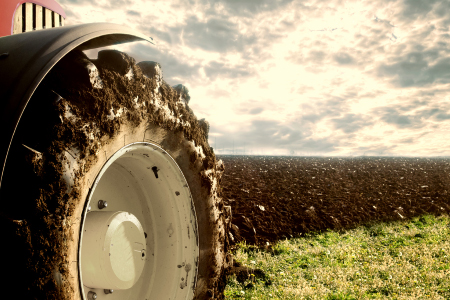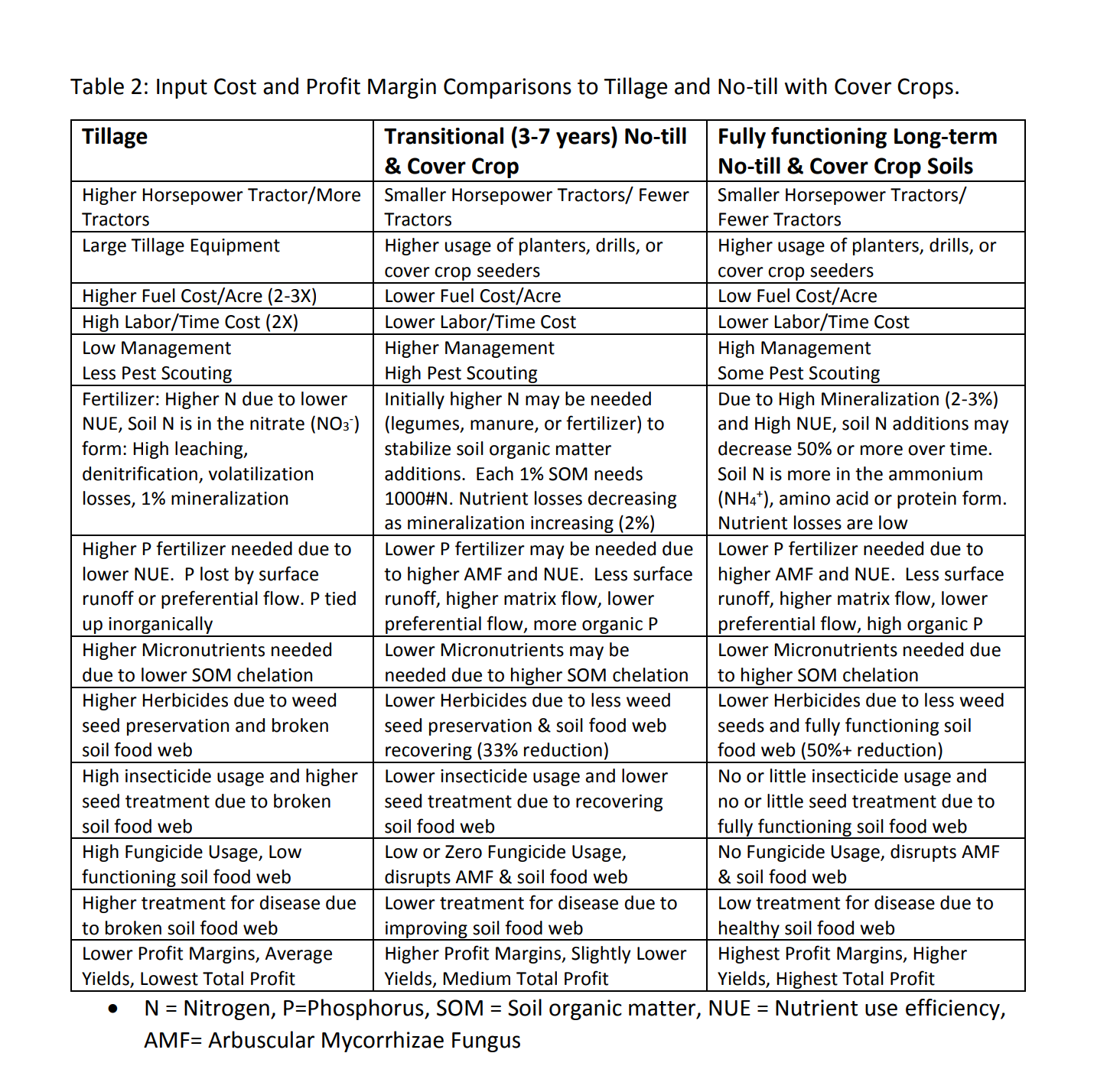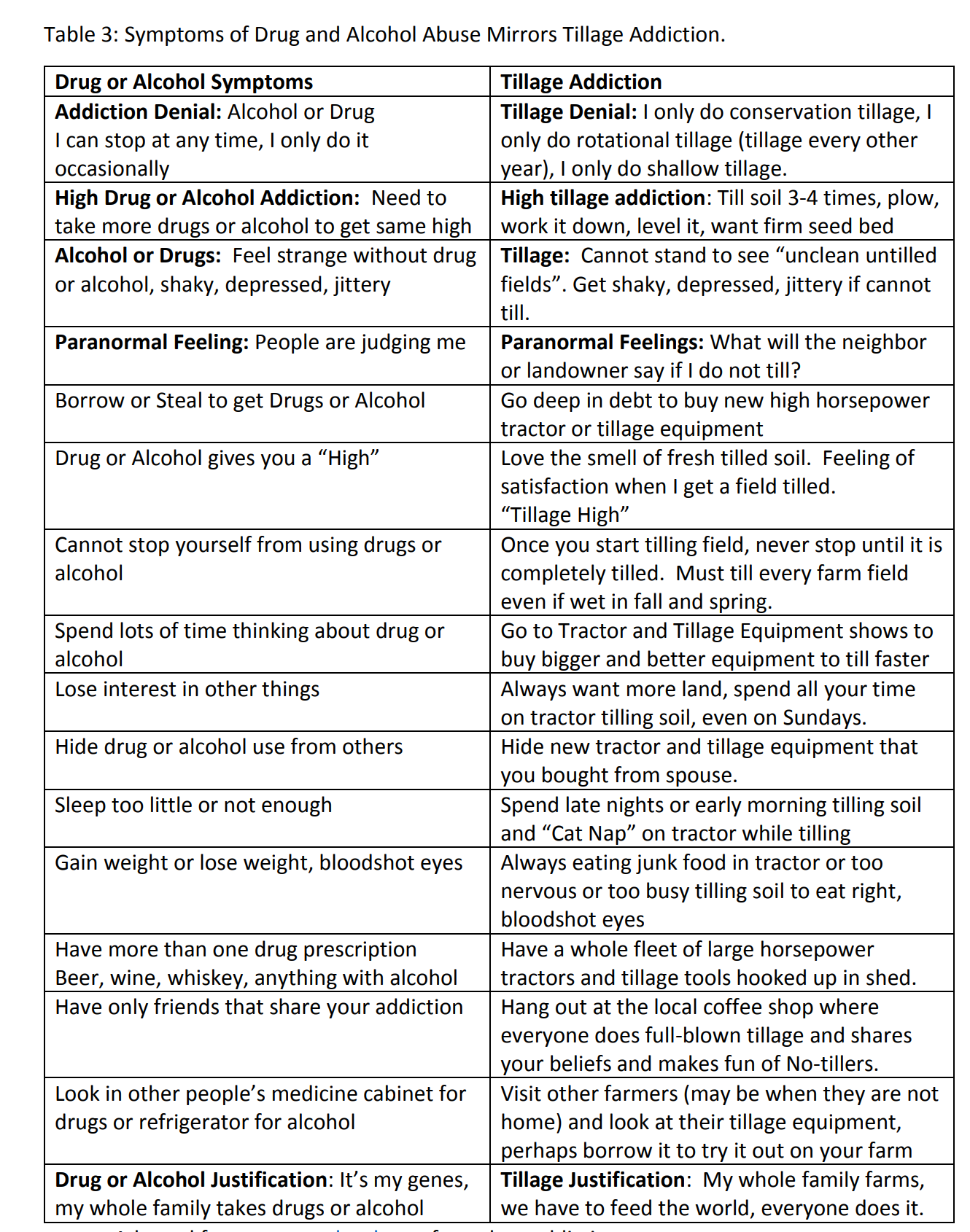Tillage is Like a Drug Addiction
Tillage is Like a Drug Addiction
By James J. Hoorman
“Strangely enough, they have a mind to till the soil and the love of possessions is a disease within them.” Sitting Bull
Civilization and the world population started increasing when humans began growing their own food to feed themselves and their livestock rather than pursuing and hunting wild game. The first human cultivation of crops probably was no-till, requiring very little cultivation. The first crops for human consumption may have been with a stick to create a hole and a seed bed for a kernel of grain. With time, our early human ancestors used livestock to speed up the planting of crops.
Tilling the soil had many early advantages. Tillage killed the weeds (short term) and reduced the competition for water and nutrients. Tillage increased seed to soil contact and helped with seed germination. Tillage also aerated the soil and increased the mineralization and release of soil nutrients and resulted in increased crop yields. Modern farmers till the soil for many of the same reasons today. Thus, the tillage addiction began early in human civilization because of all the short-term benefits (highs) that our ancestors gained from tilling the soil.
Our early ancestors still followed the wildlife, so the soils did not become exhausted. As humans started to settle in one place and till the same soil, year after year; the native soils started to wear out and lose their natural productivity by losing their soil organic matter, eroding, or losing their nutrients. At first it was easy for our ancestors to move to another virgin patch of soil and let the abandoned soil heal itself through natural plant growth, but as time went on, our ancestors settled down and were forced to continue farming the same patch of soil every year. Early farmers learned to amend the soil with manure or compost, some used crop rotation, others rested the soil with hay or pasture, and some even started using cover crops or a combination of all these practices. All these farming practices were early remedies to revitalized worn out exhausted soils. All these remedies were based on adding or managing organic or plant-based amendments (either grown or added).
While the long-term benefits of no-till and cover crops improve soil health and soil productivity are known, very few farmers today utilize this system. Why? The answer varies but the shortterm benefits or drug addiction to tillage is major hurdle to long-term soil sustainability. Tillage is like a drug, an opioid on the brain. This tillage opioid prevents most farmers and even researchers from logically acknowledging that the long-term benefits of no-till and cover crops to human civilization greatly outweigh the short-term tillage benefits. See Table 1: Short-term versus Long-term Benefits and Costs to Tillage Systems and Table 2: Input Cost and Profit Margin Comparisons to Tillage and No-till with Cover Crops.
There are many reasons why soil tillage has become so addictive. First, past generations utilized tillage with great success. The short-term benefits (the highs) to tillage are hard to ignore while the long-term benefits are often hard to see, ignored, or take time to be realized. See Table 1. Farming is a generational industry, with lessons learned the hard way passed on from one generation to the next. Grown children who want to farm mostly follow their parent’s way of farming and often need their parent’s approval to farm the land they own (and control).
Second, farming traditions and past generations put great stock in having clean freshly tilled soils. Historically, farmers took great pride in seeing who could plow the straightest and bury the residue so thoroughly, that not a single stalk was seen above ground. The traditional way of farming is a hard thing to change, once the standard has been set. Most land is owned by older generations who like things done a certain way and since they own the land, if you want to farm the land, even as a tenant, you will want to keep the landowner happy and satisfied, or risk losing the right to farm that land to someone else.
Third, freshly tilled soil smells so good! Actinomycetes in the soil release a chemical called geosmin when they die. so that sweet smell is the smell of actinomycetes dying. Most farmers love this smell, but all the tillage disrupts the natural soil food web and starts the downward spiral of soil degradation. See Figure 4: Downward Spiral to Soil Degradation with Tillage.
Fourth, tillage kills weeds. Most farmers absolutely hate weeds, yet their actions are counterproductive because tillage buries the weed seed and long-term preserves the weed seed. When a farmer re-tills the soil, they are simply replanting and repopulating weeds. Weeds ecologically grow in disturbed soils, high in soil nitrates, and high in bacteria. Weeds are the first colonizers of disturbed soils and that is where they thrive. Long-term no-till with cover crops keep the weed seed on the soil surface where they are consumed by the food web, decay, or where other hardy plants can out compete them for water, nutrients, and sunshine.
Fifth, tilling the soil with high horsepower tractors and large heavy iron equipment is a status symbol to many farmers. The investment in large tractors, expensive tillage equipment, high fuel costs, high labor and time is an expensive investment. Tillage solves problems and hides many problems on the farm short-term but the long-term costs to tilling the soil are often ignored, justified or even denied. Tillage erosion seems so small (a dimes thickness of soil loss is around 10 tons per acre soil loss) that some spring tillage can easily wipe away. Justification comes in the form that everyone tills the soil and soil erosion is a natural process. Farmers feed the world, yield are good, and if the soil erodes, fertilizer can be used to fix the problem. Outright denial comes in the form that soil erosion is manageable or nonexistent.
Once farmers start tilling a field, they seldom if ever stop tilling until the whole field is completely turned over. These are all signs of tillage addiction. Just like an alcoholic or longterm drug user, facts about long-term tillage costs can be ignored, justified, or denied. See Table 3: Symptoms of Drug and Alcohol Abuse Mirrors Tillage Addiction.
Sixth, farmers associate tillage with higher yields. Most of our modern major crops have been developed and bred for high tillage conditions, high fertilizer, and high pesticide usage. The short-term tillage benefits (drier, warm soils, good seed to soil contact, early weed termination, good soil smell) represent the drug and the associated high that farmer get because their planted crops appear to get off to an early and fast start. However, due to excess early mineralization, poor soil structure, reduced water infiltration, poor water holding capacity, lower soil organic matter; they need to use higher soil fertilization and higher rates of pesticide usage (due to broken soil food web) to get those higher yields. Thus, their profit margins are lower along with overall farm profit. The downward spiral starts as farmers need to continue to till the soil to get the same effect (high) just like drug users become addicted to the alcohol or drug the higher use to get the same high. See Figure 4: Downward Spiral to Soil Degradation with Tillage.
Tillage addiction also mirrors alcohol and drug addiction in the recovery and rehabilitation phase once tillage stops. Alcohol and drug addicts say the withdrawal period, rehab, and recovery phase are the most painful and difficult times of their lives. When a farmer stops tilling the soil, things generally get worse before they get better. All the problems that the tillage caused like poor soil structure, reduced water infiltration, soil compaction, lack of active carbon, declines long-term soil organic matter, bacteria dominated soils, and broken soil food web need to be solved or at least improved before crop yields start to recover. The recovery phase may take three to seven years, even longer if there is a relapse. Dr. Don Reicosky, Retired ARS soil scientist from Minnesota says that the first tillage pass to a long-term-no-till field wipes out 80% of the benefits with one tillage pass. Soil recovery from long-term tillage is a slow process and that is why very few farmers are successful at making the transition. This is very similar to alcohol and drug addiction, very few people succeed because it is a long and difficult process. Farmers can tolerate a slight yield reduction for one maybe two years, but very few are willing to push through the third, fourth, or fifth year of soil recovery if yields decline are suboptimal.
Tillage is very much like an alcohol or drug addiction. Relapse is very common. Farmers who till up long-term no-till fields find that the tillage addiction start all over again. Mineralization speeds up (due to oxidation), the crops look great for a couple of years (tillage high) until the soil is depleted of soil organic matter (especially active carbon) and the soil structure starts to degrade. Soon, soil erosion, excess nutrient runoff, pest problems become a major problem and the farmer needs more fertilizer and pesticides to get the same yields resulting in lower profits. Psychologist say the best way to avoid alcohol and drug addiction is not to use them and never be tempted to go back to using those drugs. The best advice for farmers is to sell the tillage tools (sell it as scrap so no one else is tempted to use it) and go to utilize long-term crop rotations with long-term no-till and cover crops. The higher profit margins, higher yields, green fields and blooming cover crops, beautiful wildlife (butterflies, birds, etc) and the reduction in environmental issues need to become a farmer’s new high. In addition, the satisfaction that future generations will be able to eat and enjoy this valuable resource, the soils that feed the world.




